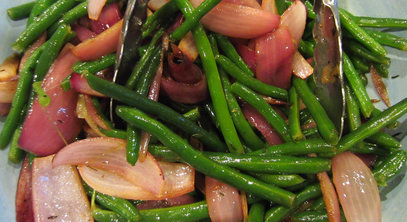
tel: 512 280-1192 Thursday, December 17, 2015
Nursery Notes: Beautiful Indian curry leaf on sale: $4.99 buy
one get one free. Dill on sale buy one 4.5" pot for $3.59, get one
free. Chimeneas in stock: $129 - $199. Fragrant piñon firewood.
35 lb bags for $24.99. Red lettuce 4" pots on sale for 55 cents
(reg $1.50) Merry Christmas everyone!

Star Wars in the Garden: to celebrate the release of 'The
Force Awakens,' the folks at Gardenista have dug up all their
old toys, and have been placing them in unlikely places in their
gardens. A fun photo essay. Gardenista

Princess Di & her Perky Turkey: over at the Winslow house-
hold for Thanksgiving, the tables were groaning under the weight
of the 'mind numbingly delicious' dishes that Diane Winslow
(owner of the nursery) and masterful chef Mick Vann were creat-
ing. For an in-depth culinary report, visit Gustidude (Pictured ab-
ove: green beans with roasted onions, blue cheese.)
___________________________________________________
Central Texas Gardener: a look at drought-defiant plants, from
trees to groundcovers. On tour, a front yard dazzles neighbors
and wildlife all year. On Sat. at 4 p.m., Sun. at 9 a.m. KLRU

T'is the Season for Poinsettias!
by Chris Winslow
The poinsettia has an assured spot at this time of year as being
top of the ‘potted plant pops.’ In this country alone we buy about
75 million… and we see them all over the place, in our offices,
homes, shops and restaurants.
No Christmas holiday decorations are complete without some
form of poinsettia.
This colorful plant, native to southern Mexico and Central Amer-
ica, was used by ancient Aztecs as a medicine to reduce fevers.
For this they used the milky white sap from its stems, and also
extracted a purplish dye from the flowering bracts.
Known as nochebuena in Mexico, this fall-flowering ornamental
would probably have remained in the jungle if it wasn’t for Joel
Roberts Poinsett (1770 – 1851), the first U.S. ambassador to
Mexico.
An amateur botanist, Poinsett brought this lovely plant (Euphor-
bia pulcherrima) back to his home in South Carolina in 1828.
Here he began propagating the “poinsettia” and sending it to his
friends and colleagues throughout the country.
The poinsettia’s leaves and stems grow during the summer months,
and begins to bloom as the days shorten in the fall.
The flowering part of the poinsettia consists of bracts and cyanthia.
The bracts are the large colored leaves which surround the cyanthia
or flowers.
In the native plant, the bracts and flowers are very small. With
the modern poinsettia, thanks to hybridization, the colorful leaves
have become much larger and you have a multitude of colors to
choose from.
We now have varieties with names like angelica, jingle belles,
celebrate, V-14 glory, freedom, and subjibe.
While the most popular color for the Christmas season is red, you
can also buy pink, salmon, white and bicolor plants.
The poinsettia is pretty easy to care for. It likes to be placed in a
well lit location and watered when it is dry.
If it has a decorative wrap around the pot, remove it when water-
ing, making sure the plant gets adequate drainage.
If you leave its roots standing in water, the plant will perish. Ideal
temperatures are 70 degrees during the day and a slightly cooler
night. Too hot a temperature will shorten its bloom time.
In the springtime, poinsettias can be grown as a potted plant or
they can be planted outside in a very protected, sunny location.
With any luck and a very late cold spell next fall, you might get
a few blooms.
I’m often asked if they’re poisonous. Experts seem to agree that
poinsettias are not toxic. An Ohio State University study showed
that a 50 pound child eating 500 leaves might get a slight tummy
ache.
____________________________________________________
Question: Are there any natural occurring plants or common
plants in the landscape that I can use to make Christmas wreaths?
One of the best plants to make wreath frames grows all over the
hill country: native grape vines.
vines can be cut and formed into circular-shaped frames.
Plants such as bay laurel, blue ice cypress, holly, and juniper can
be wired to the frame to make an evergreen cover.
Dried herbs and fruit, eucalyptus, pine cones, cinnamon, and star
anise can then be added to the wreath to add interest and fragrance.
This combination of natural products should last through the season.
Happy Holidays everyone!


Please contact newsletter editor Darrel Mayers (pictured above)
with any ideas for articles or interesting links:
internationalrain@yahoo.com (hitting 'reply' to this email won't work)
Visit the website: Its About Thyme facebook
Visit the nursery: 11726 Manchaca Road, Austin, 78748